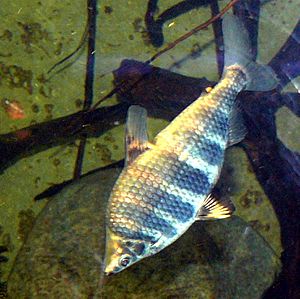Abramites hypselonotus facts for kids
Quick facts for kids Abramites hypselonotus |
|
|---|---|
 |
|
| Scientific classification | |
| Genus: |
Abramites
|
| Species: |
hypselonotus
|
The Abramites hypselonotus, also known as the marbled headstander or high-backed headstander, is a unique type of fish. It belongs to the Anostomidae family, which is part of the Characiformes group. Even though some fish classifying rules might suggest it lives near the water's surface, the marbled headstander actually prefers the middle and lower parts of the water. In the wild, you can often find these fish pointing downwards, with their tails up, hiding in narrow cracks in rocks.
Contents
What Makes Marbled Headstanders Special?
Marbled headstanders are easy to spot because of their special look. They have a high back and a pointed snout. Their body shape is like a diamond. You can also see brown markings on their pelvic fins and wavy dark brown bands along their bodies. There's also a dark line near their tail.
These fish can grow to be about 5 inches (13 cm) long. Male marbled headstanders usually have brighter colors than the females.
Where Do Marbled Headstanders Live?
You can find marbled headstanders in the rivers and streams of the Orinoco and Amazon river systems. They especially like parts of the river where the water flows very fast and there are lots of rocks.
What Do Marbled Headstanders Eat?
Marbled headstanders mostly eat plants. This means they need a lot of vegetables in their diet. Besides special fish food, they love to eat lettuce leaves and peas. They will also eat small insects like mosquito larvae and bloodworms.
Caring for Marbled Headstanders in an Aquarium
Marbled headstanders are generally peaceful fish when kept in an aquarium. When they are young, they get along well with other fish and even with other headstanders.
As they get older, it's best to keep them either by themselves or in a large group of seven or more. If you keep them in smaller groups, they might start to fight with each other. They usually remain peaceful towards other types of fish.
Because they eat a lot of plants, it's hard to keep live plants in their tank, as they will likely eat them. Make sure their aquarium has plenty of rocks, roots, and hiding spots like cracks and crevices. This helps them feel safe and prevents fighting, especially if the tank is a bit small.
Water Conditions for Headstanders
These fish can live in water with a pH from 6 to 7.5, but they prefer water that is slightly acidic. They like soft water, and the temperature should be between 73 and 82 degrees Fahrenheit (23 to 28 degrees Celsius).
See also
 In Spanish: Abramites hypselonotus para niños
In Spanish: Abramites hypselonotus para niños

